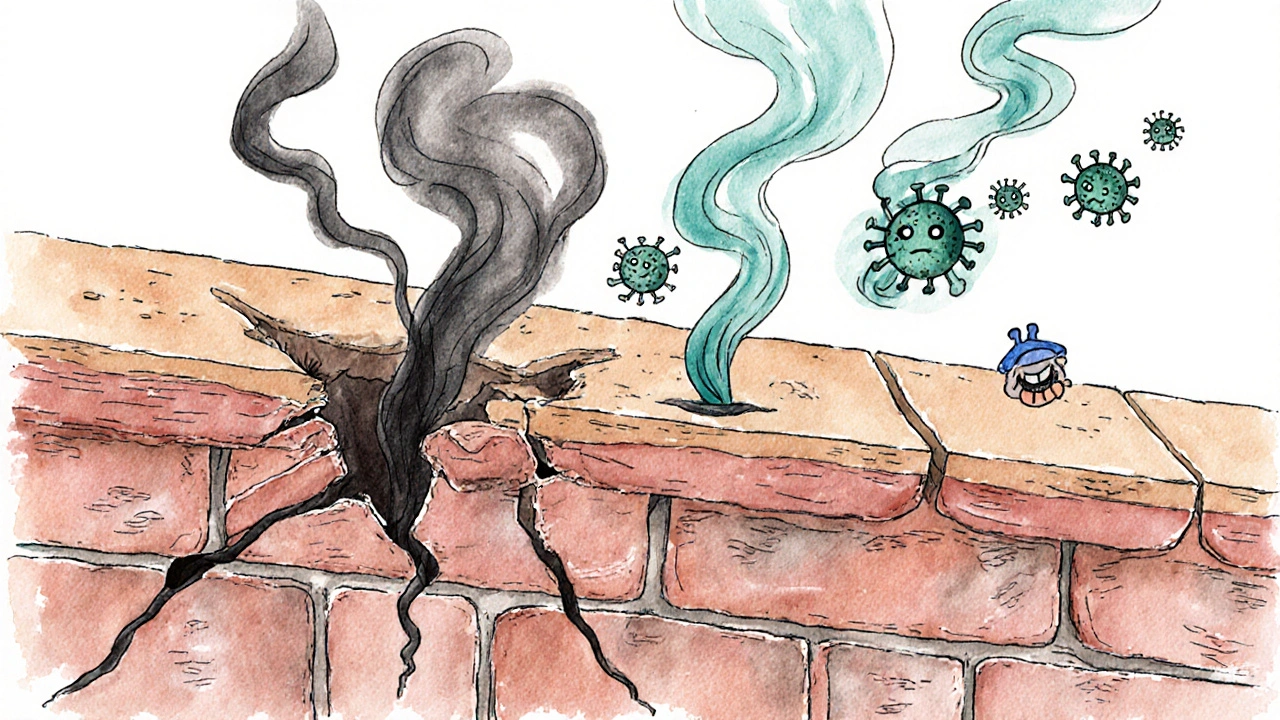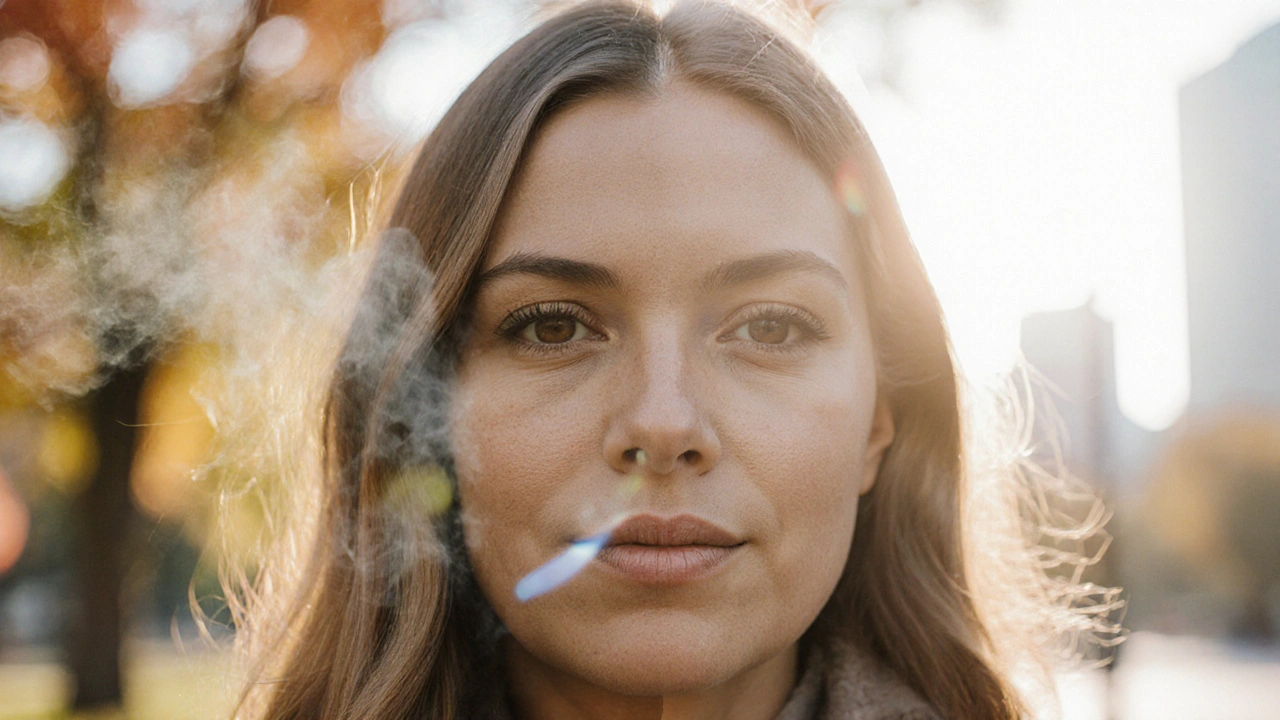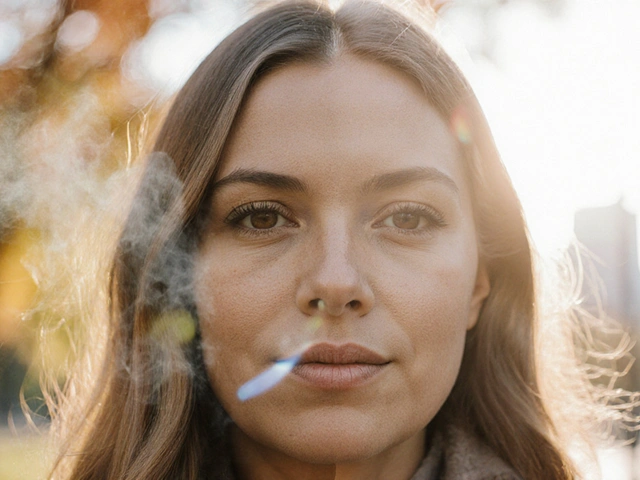Quick Take
- Smoking reduces collagen and elastin, speeding up wrinkles and loss of firmness.
- Nicotine narrows blood vessels, starving skin of oxygen and nutrients.
- Free radicals from tobacco overwhelm the skin’s antioxidant defenses.
- The immune system weakens, making bacterial and fungal infections more common.
- Quitting and targeted skin care can halt or even reverse many effects.
Smoking is a habitual inhalation of tobacco smoke that delivers nicotine, tar, and thousands of toxic chemicals into the bloodstream. It is a leading cause of preventable disease worldwide and a hidden aggressor against the skin’s health.
When you light up, the smoke travels from the lungs straight into the tiny capillaries that feed every square inch of skin. Those capillaries become clogged with carbon monoxide and tar particles, forcing skin cells to work in a low‑oxygen environment. The result? A dull complexion, premature lines, and a weakened barrier that invites microbes.
Collagen is a structural protein that gives skin its strength and elasticity. In a healthy adult, fibroblasts lay down roughly 1mg of collagen per day. Smoking cuts that production by up to 30%. The loss of collagen makes the skin sag and deepens existing wrinkles. Studies from the University of Manchester (2022) showed that long‑term smokers have a mean skin elasticity score 15% lower than non‑smokers of the same age.
Elastin is a protein that allows skin to snap back after stretching. Like collagen, elastin fibers fray faster in the presence of nicotine and free radicals, leading to the “baggy” look around eyes and cheeks.
Nicotine is a vasoconstrictor that narrows blood vessels and reduces blood flow. A single cigarette can shrink skin‑capillary diameter by 10-15%. Over time, this chronic restriction limits delivery of oxygen, vitaminC, and essential nutrients that skin needs for repair. The skin’s natural healing cycle, which normally turns over every 28days, stretches to 45days in heavy smokers.
Free radicals are highly reactive molecules that damage cellular DNA, lipids, and proteins. Tobacco smoke adds an estimated 10×10⁹ free radicals per puff. The skin’s antioxidant network-glutathione, superoxide dismutase, and vitaminsE&C-gets overwhelmed, accelerating oxidative aging.
All these chemical assaults weaken the skin’s natural barrier. A compromised barrier loses its ability to retain moisture, leading to dryness, flakiness, and micro‑tears where bacteria can slip in.
Why Smokers Get More Infections
Immune system is a complex network of cells and proteins that defend the body against pathogens. Tobacco smoke impairs the function of neutrophils, macrophages, and Langerhans cells, the skin‑resident immune defenders. A 2023 British Journal of Dermatology study found that smokers are 2.5times more likely to develop chronic bacterial skin infections such as folliculitis.
Reduced blood flow also slows the delivery of immune cells to wound sites. After a minor cut, a smoker’s skin may take up to three days longer to form a stable clot, leaving the wound open to invading microbes.
Furthermore, nicotine depresses the production of antimicrobial peptides like cathelicidin. These peptides normally act as a chemical shield on the skin surface, killing Staphylococcus aureus and other opportunistic bacteria before they can colonise.
In addition to bacterial threats, smokers report higher rates of fungal infections likeCandidaintertrigo. The humid, sweat‑rich environment under nicotine‑induced sebaceous gland changes creates a perfect breeding ground.
Visible Signs on Your Face and Body
Beyond infection risk, the visual toll of smoking is unmistakable. Look for these tell‑tale signs:
- Fine lines around the mouth - the classic “smoker’s lines” caused by repeated lip puckering and collagen loss.
- Uneven skin tone - tobacco pigments deposit in the epidermis, creating gray‑ish or brownish patches, especially on the cheeks and hands.
- Persistent dullness - reduced blood flow means less oxygen‑rich hemoglobin, which normally lends a rosy glow.
- Increased acne or comedones - nicotine stimulates sebum production, while a weakened barrier traps oil and bacteria.
- Delayed healing of wounds, burns, or surgical scars - the skin’s regenerative capacity is crippled.
These changes are not merely cosmetic; they signal deeper physiological harm that can translate into chronic conditions later in life.
Long‑Term Risks and Skin Diseases
Over years, the cumulative damage can lead to serious skin disorders:
- Psoriasis - an autoimmune condition that flares more aggressively in smokers due to systemic inflammation.
- Skin cancer - tobacco‑related carcinogens amplify UV‑induced DNA mutations, raising melanoma risk by 20% in long‑term smokers.
- Chronic venous insufficiency - nicotine‑induced vascular damage leads to leg ulcers that heal poorly.
Even if you never develop a life‑threatening disease, the aesthetic and functional decline can affect confidence, social interactions, and overall quality of life.

Ways to Reverse Damage and Protect Your Skin
Good news: the skin is remarkably resilient. When you quit smoking, the body begins a repair cascade within days.
- Boost circulation - regular aerobic exercise increases capillary density, delivering more oxygen and nutrients.
- Replenish antioxidants - foods rich in vitaminsC,E, and polyphenols (berries, nuts, leafy greens) help neutralise lingering free radicals.
- Hydrate the barrier - a ceramide‑rich moisturizer restores lipid layers, reducing transepidermal water loss.
- Use retinoids - prescription or over‑the‑counter retinol stimulates new collagen production, smoothing fine lines.
- Sun protection - broad‑spectrum SPF30+ shields the already‑compromised skin from UV‑induced DNA damage.
For infection‑prone areas, topical antiseptic washes containing chlorhexidine or tea‑tree oil can keep bacterial overgrowth at bay while the innate immune system recovers.
Practical Tips for Quitting and Skin Care
Quitting smoking is the single most effective step for skin health. Pair cessation with a skin‑focused routine to maximise benefits.
- Set a quit date and enlist a friend or support group; accountability shortens cravings.
- Replace hand‑to‑mouth habit with sugar‑free gum or a water bottle.
- Schedule a dermatologist visit within a month of quitting; they can assess damage and recommend personalized treatments.
- Track skin improvements with photos every two weeks - visual proof keeps motivation high.
- Avoid vaping as a substitution; many e‑cigarette liquids still contain nicotine and toxic aldehydes that harm skin.
Remember, your skin’s recovery timeline varies. Fine lines may take 6-12months to visibly soften, while barrier function can improve within weeks. Patience and consistency are key.
Bottom Line
Smoking attacks the skin on multiple fronts: it depletes collagen and elastin, floods cells with free radicals, narrows blood vessels, and undermines immune defenses. The combined effect speeds aging, invites infections, and lays the groundwork for serious skin diseases. The good news is that the moment you quit, your body starts rebuilding. Pair cessation with antioxidant‑rich nutrition, diligent moisturisation, and professional skin care, and you’ll see both health and beauty dividends.
| Metric | Smokers | Non‑Smokers |
|---|---|---|
| Collagen production | 30% lower | Baseline |
| Skin elasticity (measured by Cutometer) | 15% reduced | Baseline |
| Wound healing time | +3days | Standard 7days |
| Incidence of chronic bacterial infection | 2.5× higher | Reference rate |
| Wrinkle depth (mm) | 0.8mm | 0.5mm |
Frequently Asked Questions
Does occasional smoking still affect the skin?
Even light or social smoking introduces enough nicotine and free radicals to constrict blood vessels and start collagen breakdown. The impact is smaller than in heavy smokers, but over years it still adds up, especially if combined with sun exposure.
Can vaping replace smoking without harming the skin?
Vaping still delivers nicotine and thermal degradation products that can impair blood flow and antioxidant capacity. While e‑cigarettes lack many tar compounds, they are not skin‑friendly and can still accelerate aging.
How soon after quitting will my skin look better?
Within two weeks you may notice a fresher complexion and reduced redness, as circulation improves. Noticeable softening of fine lines typically appears after 6-12months of consistent care.
Are there specific foods that help repair smoking‑damaged skin?
Yes. Foods high in vitaminC (citrus, kiwi), vitaminE (almonds, sunflower seeds), and polyphenols (green tea, dark chocolate) boost the skin’s antioxidant network. Omega‑3 rich fish also support cell membrane integrity.
Should I use prescription retinoids after quitting?
Prescription retinoids are the most effective way to stimulate new collagen in heavily damaged skin. They should be used under dermatologist supervision, especially if you have sensitive skin post‑quit.







Randy Faulk
September 28, 2025Nicotine’s vasoconstriction sharply reduces cutaneous perfusion, accelerating the formation of fine lines and dullness. The diminished oxygen delivery also hampers fibroblast activity, leading to a measurable drop in collagen synthesis. Over weeks, the skin barrier becomes porous, inviting bacterial colonisation. Incorporating aerobic exercise can gradually restore capillary density, mitigating some of these effects. Antioxidant‑rich foods further support the skin’s defensive pathways.